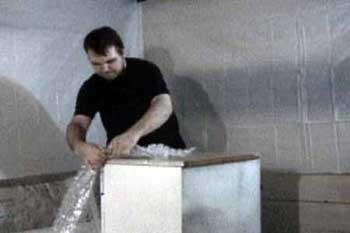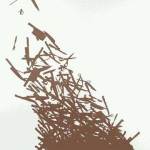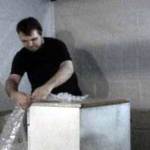In a society colored, shaped and devised to nurture our short attention spans, a focus on obsession is strangely refreshing. OCD (referencing Obsessive Compulsive Disorder), now showing at the Mills Gallery at Boston Center for the Arts is the fruit of eight artists paying rare attention to detail and subject over long periods of time. A foreign idea to many today, the focus on this “extreme” behavior undermines the show almost, seeming to focus only on this surface level obsession, rather than the uncomfortable and sometimes frightening obsession associated with OCD.
Luke Walker’s hip-camera photo series of mostly female backsides lacks the particularity of obsession. This subject is so often pursued in film, television, and literature that the eerie specificity of those obsessed cannot easily be faked. The quantity of photographs certainly hints at an unnatural interest. The fact that these prints were made on an ink-jet printer, a sort of do-it-yourself technique, gives an air of secrecy to the process—an unwillingness to be caught in the act. But that same unwillingness takes away from Walker’s photos—these subjects weren’t studied, but seemingly picked at random. His quick shots, some of which are difficult to even make out, simply do not look premeditated enough to be believable. It is clear that Walker is playing the part of one obsessed, superficially going through the motions, rather than trying to get to the heart of what the afflicted specifically desire.
Instead of quantity, many of the artists on display capitalized on time—the ridiculous amount of hours and days spent completing their labor of love. Jason Dean’s "570 square feet of bubblewrap popped in 15 hours, 58 minutes", of various lengths and bubble sizes sacrifices visual aesthetic almost completely to discuss a period of time. Spools of spent bubblewrap hang from the gallery walls accompanied by a video featuring Dean in the act of popping the bubbles. Video sound is key here, working with the artist’s invitation to the viewer to touch the popped bubblewrap. Feeling the wrap and hearing the sounds, one instantly wants the satisfaction of popping bubbles that are no longer there for the taking. While not a shockingly original piece, this subtle power play does accentuate the bizarre satisfaction gained from obsessive acts. It is a satisfaction that you are purposefully being denied by Dean, but which he has gained through the execution of this very act that you have been made to vicariously experience.
A bit more successful in their discussion of duration of process are the six ink pieces by Joseph Trupia. "What I can do in forty hours", for example, is an entire 30”x22” piece of paper covered with tiny ink drawn circles. The monotony involved in the creation of each of Trupia’s pieces is easily imagined by the viewer. Though pleasing to the eye, it’s debatable whether the actual completed piece was as important as the time and labor necessary to get there.
Perhaps the strongest of Trupia’s six pieces is "A Very Real Misuse of Resources". Here Trupia has darkly and carefully colored in a 30”x22” piece of paper with a ball point pen. No mention is made of the time it took to complete this project, leaving the viewer to ponder. The obvious effort involved in getting to a result that is visually unspectacular leads us to question why Trupia made this piece, and therein lies the message. The compulsion present in the repetitive action of coloring furiously in the unforgiving medium of ball point pen makes us uncomfortable, especially when it is done with such care. Of any piece in this entire show, "A Very Real Misuse of Resources" smacks the most of actual OCD.
In terms of craft, Matthew Nash and Morgan Phelan’s offerings stand out as accomplished and well composed among the other works. Nash’s creation of WWII stills with M&Ms, part of a photographic/sculptural series called "The Children’s War", are as poignant up close as they are from across the room. From afar we can appreciate his attention to form and color, as well as the series’ preoccupation with warfare. Upon closer inspection, we focus on each individual candy in these photos, understanding Nash’s work as an act of obsession through process as well. The medium of candy juxtaposes itself powerfully with its subject, making for a multi-layered, sophisticated commentary on war in general, and who is doing the fighting.
Morgan Phelan’s untitled cut paper series focuses on obsession through creation as well. Paper carefully coaxed into the shapes of delicate cutting instruments using…delicate cutting instruments creates a playful awareness of process within the series. Phelan’s ability to take the violence out of iconographic objects such as butcher knives and daggers is impressive. His process adds to his message by demonstrating the delicacy and beauty these sharp objects can create.
Like Phelan’s series, Nancy Havelik’s "Sugar Egg Rug" obsesses over time spent in the creation of the delicate. Her large floor piece is completely composed of sugar products--very breakable and very time consuming to form. Jennifer Schmidt’s Scantron installation was surely as arduous in process, but I did not sense a particular depth or preoccupation within, except for the noted use of #2 pencils. I felt a similar lack of depth in Chris Francione’s "Untraceable", which with all its detail made my eye jump quickly from pop art paint chip to paint chip, actually indulging my short attention span, rather than challenging it to make an in depth analysis of the piece as a whole.
Although an intriguing show, OCD treats obsession rather superficially overall, becoming the epitome of OCD’s usage today as a slang word, rather than a psychological term. This in itself should cause us to wonder if within our “ADHD” society, short attention spans have become the norm. Is devoting time to a project or paying attention to detail considered obsessive these days?
- Infantry, June 5, 1944 from the series The Children’s War by Matthew Nash.
- A cut paper piece by Morgan Phalen.
- Still from video entitled 48 inches by 110 feet, 1 inch diameter bubbles: 4 hours, 23 minutes, an excerpt by Jason Dean.
Links:
OCD Exhibition (including links to other press reviews
Boston Center for the Arts
Obsessed?: OCD – showing through May 9 at the Mills Gallery, Boston Center for the Arts
All images are courtesy of the artists and The Mills Gallery, Boston.
Beth Martin is the Music and Arts editor of SubterraBoston.com. She is also a graduate of the Film department of Boston Univ.






